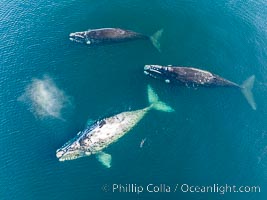
Courting group of southern right whales, aerial photo. Mating may occur as a result of this courting and social behavior. The white whale seen here is a serious player named El Copulador (the copulator) and is often seen in mating and courting groups of southern right whales at Peninsula Valdes. His light coloration is an indication that he was a white calf, but he did not darken as he aged in the way most white southern right whale calves do.
Species: Southern Right Whale, Eubalaena australis
Location: Puerto Piramides, Chubut, Argentina
Image ID: 38360
Species: Southern Right Whale, Eubalaena australis
Location: Puerto Piramides, Chubut, Argentina
Image ID: 38360

Mother and calf southern right whales are seen here as part of a larger courtship group, with adult males interested in mating with the mother. The calf has no choice but to stay by her mother's side during the courting activities.
Species: Southern Right Whale, Eubalaena australis
Location: Puerto Piramides, Chubut, Argentina
Image ID: 38380
Species: Southern Right Whale, Eubalaena australis
Location: Puerto Piramides, Chubut, Argentina
Image ID: 38380
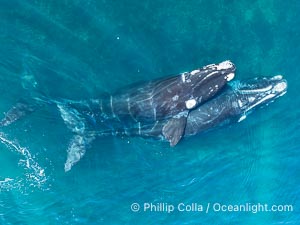
Mating pair of Southern Right Whales, aerial photo. In this photo, the male is grasping the female with one of his pectoral fins as a prelude to copulation. By permission of the Government of Argentina, Chubut, permit # 51 / 2025-SsCyA.
Species: Southern Right Whale, Eubalaena australis
Location: Puerto Piramides, Chubut, Argentina
Image ID: 41196
Species: Southern Right Whale, Eubalaena australis
Location: Puerto Piramides, Chubut, Argentina
Image ID: 41196
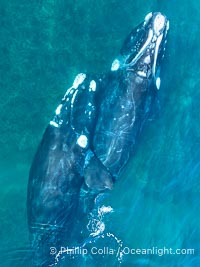
Mating pair of Southern Right Whales, aerial photo. In this photo, the male is grasping the female with one of his pectoral fins as a prelude to copulation. By permission of the Government of Argentina, Chubut, permit # 51 / 2025-SsCyA.
Species: Southern Right Whale, Eubalaena australis
Location: Puerto Piramides, Chubut, Argentina
Image ID: 41197
Species: Southern Right Whale, Eubalaena australis
Location: Puerto Piramides, Chubut, Argentina
Image ID: 41197

Courting Pair of Southern Right Whales, Aerial Photo. By permission of the Government of Argentina, Chubut, permit # 51 / 2025-SsCyA.
Species: Southern Right Whale, Eubalaena australis
Location: Puerto Piramides, Chubut, Argentina
Image ID: 41213
Species: Southern Right Whale, Eubalaena australis
Location: Puerto Piramides, Chubut, Argentina
Image ID: 41213

Copulating Pair of Southern Right Whales, aerial photo.The male is at left, female at right, and the female's calf at upper right. By permission of the Government of Argentina, Chubut, permit # 51 / 2025-SsCyA.
Species: Southern Right Whale, Eubalaena australis
Location: Puerto Piramides, Chubut, Argentina
Image ID: 41219
Species: Southern Right Whale, Eubalaena australis
Location: Puerto Piramides, Chubut, Argentina
Image ID: 41219

Courtship group of six Southern right whales, Eubalaena australis, Argentina.
Species: Southern right whale, Eubalaena australis
Location: Puerto Piramides, Chubut, Argentina
Image ID: 35915
Species: Southern right whale, Eubalaena australis
Location: Puerto Piramides, Chubut, Argentina
Image ID: 35915
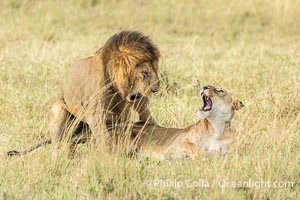
Mating pair of African lions, Masai Mara, Kenya.
Species: African lion, Panthera leo
Location: Maasai Mara National Reserve, Kenya
Image ID: 39635
Species: African lion, Panthera leo
Location: Maasai Mara National Reserve, Kenya
Image ID: 39635
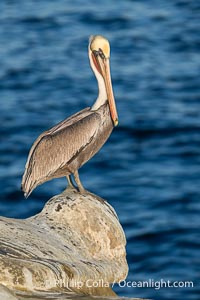
Brown Pelican on Pedestal Rock Portrait at Sunrise, adult non-breeding winter plumage.
Species: Brown Pelican, Pelecanus occidentalis, Pelecanus occidentalis californicus
Location: La Jolla, California
Image ID: 39810
Species: Brown Pelican, Pelecanus occidentalis, Pelecanus occidentalis californicus
Location: La Jolla, California
Image ID: 39810
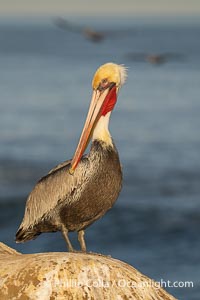
Sunrise Portrait of Brown Pelican Perched Over the Pacific Ocean, non-breeding adult winter plumage.
Species: Brown Pelican, Pelecanus occidentalis, Pelecanus occidentalis californicus
Location: La Jolla, California
Image ID: 39814
Species: Brown Pelican, Pelecanus occidentalis, Pelecanus occidentalis californicus
Location: La Jolla, California
Image ID: 39814

A brown pelican preening, reaching with its beak to the uropygial gland (preen gland) near the base of its tail. Preen oil from the uropygial gland is spread by the pelican's beak and back of its head to all other feathers on the pelican, helping to keep them water resistant and dry. Adult winter breeding plumage.
Species: Brown Pelican, Pelecanus occidentalis, Pelecanus occidentalis californicus
Location: La Jolla, California
Image ID: 40020
Species: Brown Pelican, Pelecanus occidentalis, Pelecanus occidentalis californicus
Location: La Jolla, California
Image ID: 40020

California Brown Pelican claps its jaws mandibles, sometimes rapidly several times, perhaps to dislodge debris or simply because its fun and feels good. This is not the same as the "yawn" that precedes a head throw. Adult winter breeding plumage with brown hind-neck.
Species: Brown Pelican, Pelecanus occidentalis, Pelecanus occidentalis californicus
Location: La Jolla, California
Image ID: 40239
Species: Brown Pelican, Pelecanus occidentalis, Pelecanus occidentalis californicus
Location: La Jolla, California
Image ID: 40239

Western Grebes rushing across Lake Wohlford, exhibiting a spectacular courtship behavior in which the aquatic birds literally run across the surface of the water while their feet hit the water up to 20 times per second. The grebe on the left is "Hook" famous for the fishing hook and line embedded in the back of his head.
Species: Western Grebe, Aechmophorus occidentalis
Location: Lake Wohlford, Escondido, California
Image ID: 40843
Species: Western Grebe, Aechmophorus occidentalis
Location: Lake Wohlford, Escondido, California
Image ID: 40843
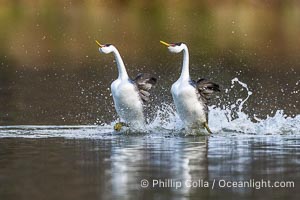
Western Grebe Rushing, Running Across Water.
Species: Western Grebe, Aechmophorus occidentalis
Location: Lake Wohlford, Escondido, California
Image ID: 40844
Species: Western Grebe, Aechmophorus occidentalis
Location: Lake Wohlford, Escondido, California
Image ID: 40844
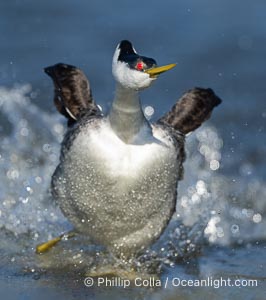
Extreme closeup view of a Western Grebe as it rushes, running across the water as part of an elaborate courtship behavior.
Species: Western Grebe, Aechmophorus occidentalis
Location: Lake Wohlford, Escondido, California
Image ID: 40845
Species: Western Grebe, Aechmophorus occidentalis
Location: Lake Wohlford, Escondido, California
Image ID: 40845
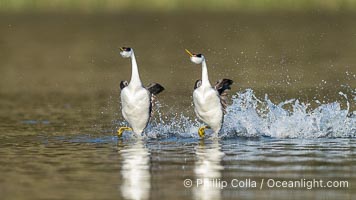
Two Western Grebes in a Spectacular Rush Across the Surface of Lake Wohlford. Rushing is a courtship behavior among grebes and requires the aquatic birds to step as rapidly as 20 beats per second to walk across water in this way. Simply amazing.
Species: Western Grebe, Aechmophorus occidentalis
Location: Lake Wohlford, Escondido, California
Image ID: 40868
Species: Western Grebe, Aechmophorus occidentalis
Location: Lake Wohlford, Escondido, California
Image ID: 40868

Western Grebes Ratchet Pointing, a courtship behavior in which the grebes assume a low facing position in the water, point beaks at one another and emit a ratchet-like sound. Coupled with dip-shaking, several rounds of ratchet pointing is often an immediate precursor to rushing.
Species: Western Grebe, Aechmophorus occidentalis
Location: Lake Wohlford, Escondido, California
Image ID: 40893
Species: Western Grebe, Aechmophorus occidentalis
Location: Lake Wohlford, Escondido, California
Image ID: 40893

Two Rushing Western Grebes Walk on Water. Grebe rushing, a courtship behavior, happens when the birds slap the lake surface up to 20 times per second, literally running across the water.
Species: Western Grebe, Aechmophorus occidentalis
Location: Lake Wohlford, Escondido, California
Image ID: 40912
Species: Western Grebe, Aechmophorus occidentalis
Location: Lake Wohlford, Escondido, California
Image ID: 40912
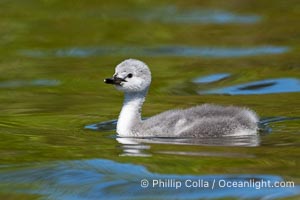
Western Grebe Chick.
Species: Western Grebe, Aechmophorus occidentalis
Location: Lake Hodges, San Diego, California
Image ID: 40970
Species: Western Grebe, Aechmophorus occidentalis
Location: Lake Hodges, San Diego, California
Image ID: 40970
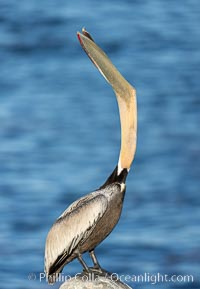
California Brown Pelican head throw, stretching its throat to keep it flexible and healthy. Note the unusual yellow coloration of the gular pouch, which is normally red in winter adults. Yellow morph.
Species: Brown Pelican, Pelecanus occidentalis, Pelecanus occidentalis californicus
Location: La Jolla, California
Image ID: 36714
Species: Brown Pelican, Pelecanus occidentalis, Pelecanus occidentalis californicus
Location: La Jolla, California
Image ID: 36714
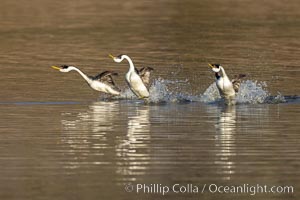
Three Western Grebes Rushing on Lake Hodges.
Species: Western grebe, Aechmophorus occidentalis
Location: Lake Hodges, San Diego, California
Image ID: 36779
Species: Western grebe, Aechmophorus occidentalis
Location: Lake Hodges, San Diego, California
Image ID: 36779
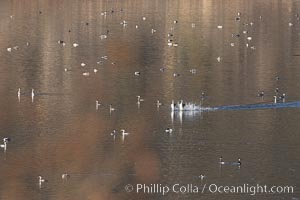
Western Grebes Rushing on Lake Hodges, amidst a mix of Western Grebes and Clarks Grebes.
Species: Western grebe, Aechmophorus occidentalis
Location: Lake Hodges, San Diego, California
Image ID: 36790
Species: Western grebe, Aechmophorus occidentalis
Location: Lake Hodges, San Diego, California
Image ID: 36790
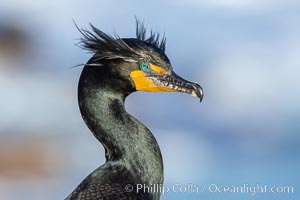
Double-crested cormorant nuptial crests, tufts of feathers on each side of the head, plumage associated with courtship and mating.
Species: Double-crested cormorant, Phalacrocorax auritus
Location: La Jolla, California
Image ID: 36847
Species: Double-crested cormorant, Phalacrocorax auritus
Location: La Jolla, California
Image ID: 36847

Brown pelicans jousting, with bright red throat, yellow and white head and brown hind neck, winter plumage.
Species: Brown Pelican, Pelecanus occidentalis, Pelecanus occidentalis californicus
Location: La Jolla, California
Image ID: 37606
Species: Brown Pelican, Pelecanus occidentalis, Pelecanus occidentalis californicus
Location: La Jolla, California
Image ID: 37606

Portrait of two California brown pelicans with breeding plumage, note the striking red throat, yellow and white head.
Species: Brown Pelican, Pelecanus occidentalis, Pelecanus occidentalis californicus
Location: La Jolla, California
Image ID: 37607
Species: Brown Pelican, Pelecanus occidentalis, Pelecanus occidentalis californicus
Location: La Jolla, California
Image ID: 37607

A California brown pelican preening, rubbing the back of its head and neck on the uropygial gland (preen gland) near the base of its tail. Preen oil from the uropygial gland is spread by the pelican's beak and back of its head to all other feathers on the pelican, helping to keep them water resistant and dry. Adult winter non-breeding plumage showing white hindneck and red gular throat pouch (but transitioning to brown hind neck).
Species: Brown Pelican, Pelecanus occidentalis, Pelecanus occidentalis californicus
Location: La Jolla, California
Image ID: 37627
Species: Brown Pelican, Pelecanus occidentalis, Pelecanus occidentalis californicus
Location: La Jolla, California
Image ID: 37627
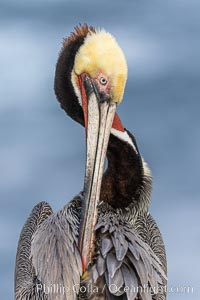
A brown pelican preening, reaching with its beak to the uropygial gland (preen gland) near the base of its tail. Preen oil from the uropygial gland is spread by the pelican's beak and back of its head to all other feathers on the pelican, helping to keep them water resistant and dry.
Species: Brown Pelican, Pelecanus occidentalis, Pelecanus occidentalis californicus
Location: La Jolla, California
Image ID: 37693
Species: Brown Pelican, Pelecanus occidentalis, Pelecanus occidentalis californicus
Location: La Jolla, California
Image ID: 37693
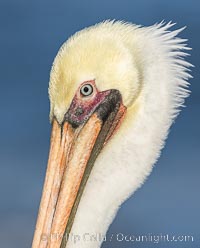
Brown pelican close-up portrait, orange-red bill with pink tissue surrounding eyes, yellow and white head feathers, adult winter non-breeding plumage.
Species: Brown Pelican, Pelecanus occidentalis, Pelecanus occidentalis californicus
Location: La Jolla, California
Image ID: 38587
Species: Brown Pelican, Pelecanus occidentalis, Pelecanus occidentalis californicus
Location: La Jolla, California
Image ID: 38587
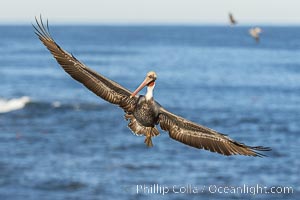
Brown pelican in flight with wings spread wide, slowing as it returns from the ocean to land on seacliffs, adult winter non-breeding plumage.
Species: Brown Pelican, Pelecanus occidentalis, Pelecanus occidentalis californicus
Location: La Jolla, California
Image ID: 38588
Species: Brown Pelican, Pelecanus occidentalis, Pelecanus occidentalis californicus
Location: La Jolla, California
Image ID: 38588

California brown pelican full body portrait, perched on rock over the ocean in sunlight, adult winter non-breeding plumage.
Species: Brown Pelican, Pelecanus occidentalis, Pelecanus occidentalis californicus
Location: La Jolla, California
Image ID: 38591
Species: Brown Pelican, Pelecanus occidentalis, Pelecanus occidentalis californicus
Location: La Jolla, California
Image ID: 38591